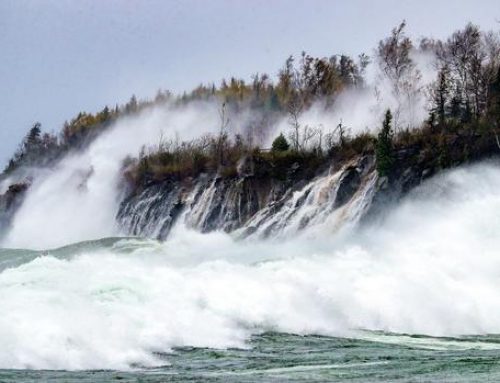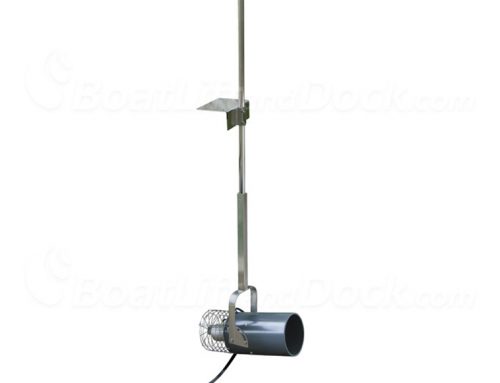When we buy something we are used to thinking of it as our possession; once money leaves our pocket, we own it. Most of us share our homes and even our cars with our family and perhaps friends but for the most part, what we buy we own. Yet, if we take the time to think about it, many of the things we own, especially those that are exposed to nature, are borrowed or used by others. In a related article we discussed some bird deterrent options for dealing with geese and seas gulls. Here we will get into some issues surrounding some of the smaller but no less troublesome inhabitants of your waterfront.
Your boat lift, dock, as well as your watercraft, are inevitably placed in an environment that is full of life; creatures that are in as much of a need of a place to hang their hats as we are. All it takes is a little time to investigate the details of the situation and it is likely that you will find that many tenants have moved into the voids of your boat lift or under your dock; building a home in the convenient structures that you have installed along the waterfront.
The rather troublesome presence of these residents or “pests” is inevitable, after all we have little choice but to share our own environment with many other forms of life, both plant and insect, and in some areas certain members of the rodent family whose antics can cause serious damage to your watercraft and associated gear. In this article we will discuss the presence of some of these creatures and how you can go about managing their impact on your boating experience.
Looking at your boat lift, and even your dock, it is easy to see that there are aspects of their construction that provide excellent homes for bees and spiders, and other insects that may be particular to your waterfront landscape. In my home in Upstate NY, the main “pest” that we had to deal with every year was the red squirrel, a creature that will chew through almost anything and make a home; proving very difficult to root out and get rid of.
Squirrels and Other Rodents
Now, the red squirrel may not be present where you live, and as far as I know, they do not make homes in boat lifts as they prefer dry conditions to the damp and cold of the waterfront, yet, they do represent an aspect of a particular environment that you may have to deal with. In particular the red squirrel was fond of the spaces and voids on our boat and our camping trailer, chewing up life preservers and wires, something that may occur to you if you park your watercraft in an area that opens access to land-born critters looking for a home.
I am not going to provide you any specific solution to getting rid of these creatures all together; anyone who has taken a seasonal dock or boat lift out in the late summer has experienced the frenzy of spiders scurrying up their back or arm to avoid being dunked into the lake; they are there and they will always be there so the best option is to monitor them and simply be aware of them. The best approach to this issue has to be tailored to your situation.
Bees
If you have a boat lift and you have noticed that bees like to nest in the upright, accessing the convenient spaces built into its structure, i.e., the many holes and voids that are easy to spot in the framework of most boat lift designs are excellent front and back doors to a bee hive. The best way that we have found to address this issue is to get out your caulking gun and close these doors with a dab or two of clear silicone. This is a very effective and inexpensive way to eliminate the convenience that these holes provide to the bee, it will pass on looking for homes that require less labor.
Spiders
The spider, however, may not be as easy to eliminate, they may use some of these holes on your lift and the silicone may diminish their options, but the spider is more likely to show up under your dock or canopy frame where silicone will not help you. In this instance the best advice we can offer is diligence. Get to know the species that are in your area, knowing which ones pose a danger to you and your family and which ones are simply creepy is the best weapon you can deploy. There are chemicals available on the market to address these critters yet many of these are more damaging than even the red squirrel, posing health risks to you and the environment in general.
By far the best approach is to become informed. Getting to know what species share your waterfront gives you an insight into their habits and any threat they may represent. Bees will, for the most part, will keep to themselves;only stinging when threatened. When this happens it is often in multiple numbers, and removing them is the best option; no one wants their day ruined or life threatened by disrupting the relative calm of a bees nest. Knowing they are there or will likely build a home in your lift is the best defense. Spiders on the other hand are best dealt with through knowing their ways, if they are there find out if they are a threat, then take precautions when working around the waterfront.
In the end we are living and playing in an environment inhabited by indigenous species that have a far older and more insistent claim to the landscape. We have to live with these creatures as they will return season after season to live in and on or under the tools and toys we bring into the situation and the best advice we can offer is a working knowledge of their presence and ways. Take notice of when they arrive and how they set up shop and then take whatever reasonable steps you can to deal with or live with them. This effort will pay off in either a removal of the issue or at least an increased comfort with their presence.
The variety of life that we have to deal with is far too great to catalog here and we would be glad to hear from you about your specific experience and how you have addressed it; in the end we seek to present as much information as possible and any comments or feedback will be greatly appreciated.
If you need some help identifying the insects on your property follow these helpful links:
© 2013 BoatLiftandDock.com








